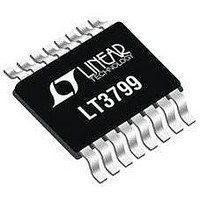LT3799EMSE#PBF Linear Technology, LT3799EMSE#PBF Datasheet - Page 10

LT3799EMSE#PBF
Manufacturer Part Number
LT3799EMSE#PBF
Description
IC, LED DRVR, MSOP-16
Manufacturer
Linear Technology
Datasheet
1.LT3799EMSEPBF.pdf
(20 pages)
Specifications of LT3799EMSE#PBF
Led Driver Application
High Power LED Driver, Automotive Lighting
No. Of Outputs
1
Output Current
3A
Input Voltage
18V
Dimming Control Type
Analog
Topology
Flyback
Rohs Compliant
Yes
Lead Free Status / RoHS Status
Lead free / RoHS Compliant
Available stocks
Company
Part Number
Manufacturer
Quantity
Price
LT3799
converted to a current into the multiplier with the V/I
converter, A6. Since A7’s output is constant, the output
of the multiplier is proportional to A6 and can be ignored.
The output of the multiplier controls the peak current with
its connection to the current comparator, A1. The output
of the multiplier is also connected to the transmission
gate, SW1. The transmission gate, SW1, turns on when
the secondary current flows to the output capacitor. This
is called the flyback period (when the output diode D1 is
on). The current through the 1M resistor gets integrated
by A5. The lowest CTRL input is equal to the negative input
of A5 in steady state.
A current output regulator normally uses a sense resistor
in series with the output current and uses a feedback loop
to control the peak current of the switching converter. In
this isolated case the output current information is not
available, so instead the LT3799 calculates it using the
information available on the primary side of the transformer.
The output current may be calculated by taking the average
of the output diode current. As shown in Figure 1, the diode
current is a triangle waveform with a base of the flyback
time and a height of the peak secondary winding current.
In a flyback topology, the secondary winding current is N
times the primary winding current, where N is the primary
to secondary winding ratio. Instead of taking the area of
the triangle, think of it as a pulse width modulation (PWM)
waveform. During the flyback time, the average current
is half the peak secondary winding current and zero dur-
OPERATION
10
Figure 1. Secondary Diode Current and Switch Waveforms
SECONDARY
DIODE CURRENT
SWITCH
WAVEFORM
I
PK(sec)
T
PERIOD
T
FLYBACK
3799 F01
ing the rest of the cycle. The equation for expressing the
output current is:
where D´ is equal to the percentage of the cycle represented
by the flyback time.
The LT3799 has access to both the primary winding cur-
rent, the input to the current comparator, and when the
flyback time starts and ends. Now the output current can
be calculated by averaging a PWM waveform with the
height of the current limit and the duty cycle of the flyback
time over the entire cycle. In the feedback loop previously
described, the input to the integrator is such a waveform.
The integrator adjusts the peak current until the calculated
output current equals the control voltage. If the calculated
output current is low compared to the control pin, the error
amplifier increases the voltage on the COMP
increasing the current comparator input.
When the V
divider of the supply voltage, the current limit is propor-
tional to the supply voltage if COMP
The output of the error amplifier is multiplied with the
V
fast control loop, slower changes from the V
will not interfere with the current limit or the output current.
The COMP
The only way for the multiplier to function properly is to
set the control loop to be an order of magnitude slower
than the fundamental frequency of the V
the offline case, the fundamental frequency of the supply
voltage is 120Hz, so the control loop unity gain frequency
needs to be set less than approximately 120Hz. Without a
large amount of energy storage on the secondary side, the
output current is affected by the supply voltage changes,
but the DC component of the output current is accurate.
TRIAC Dimming Features
The LT3799 incorporates some special features that aid in
the design of an offline LED current source when used with
a TRIAC dimmer. TRIAC dimmers are not ideal switches
when turned off and allow milliamps of current to flow
through them. This is an issue if used with a low quiescent
part such as the LT3799. Instead of turning the main power
IN_SENSE
I
OUT
= 0.5 • I
pin voltage. If the LT3799 is configured with a
+
pin will adjust to the changes of the V
IN_SENSE
PK
• N • D´
voltage is connected to a resistor
+
IN_SENSE
is held constant.
+
IN_SENSE
node, thus
IN_SENSE
signal. In
3799f
pin
.













